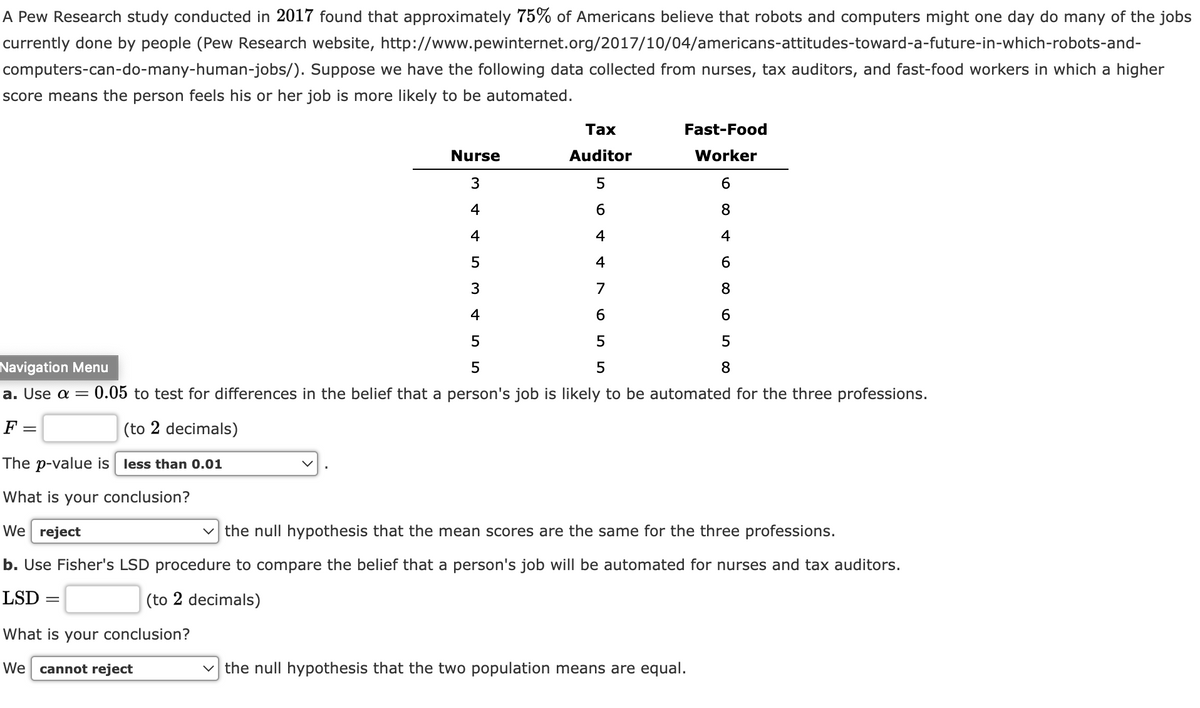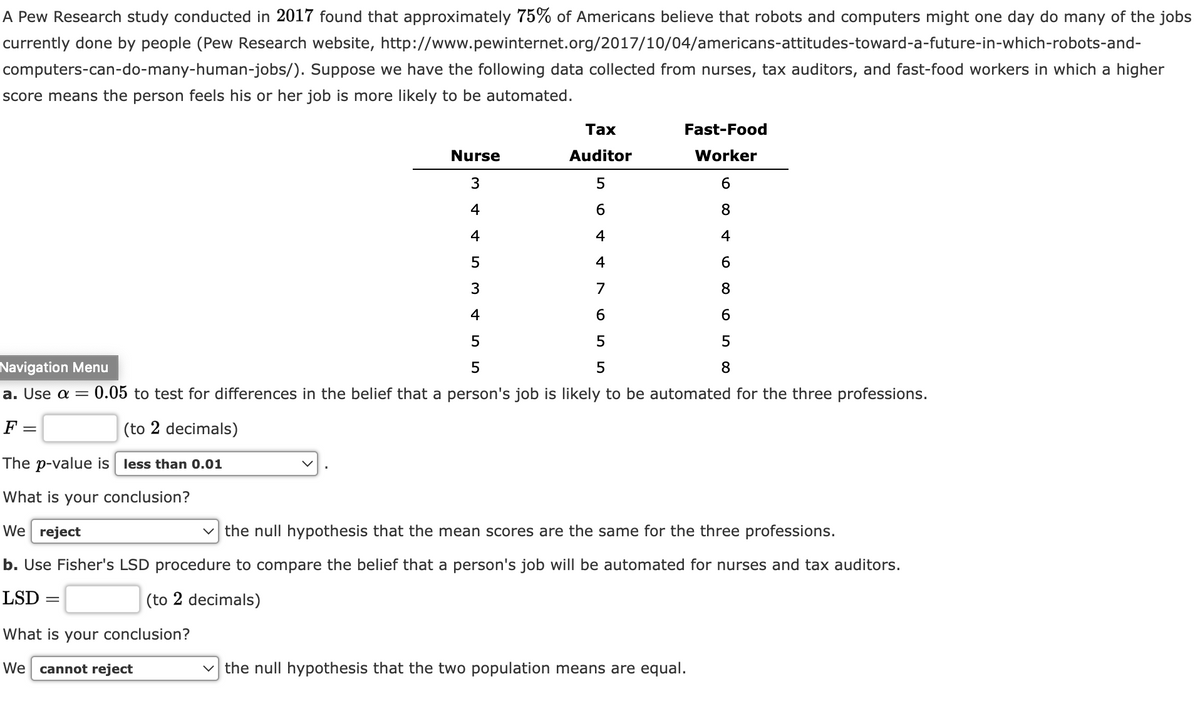Nurse 3 4 4 5 3 4 What is your conclusion? We cannot reject Tax Auditor Fast-Food Worker 6 8 4 6 8 6 5 8 5 6 4 4 7 6 5 5 5 5 Navigation Menu a. Use α = 0.05 to test for differences in the belief that a person's job is likely to be automated for the three professions. F = (to 2 decimals) The p-value is less than 0.01 What is your conclusion? We reject ✓the null hypothesis that the mean scores are the same for the three professions. b. Use Fisher's LSD procedure to compare the belief that a person's job will be automated for nurses and tax auditors. LSD = (to 2 decimals) the null hypothesis that the two population means are equal.
Nurse 3 4 4 5 3 4 What is your conclusion? We cannot reject Tax Auditor Fast-Food Worker 6 8 4 6 8 6 5 8 5 6 4 4 7 6 5 5 5 5 Navigation Menu a. Use α = 0.05 to test for differences in the belief that a person's job is likely to be automated for the three professions. F = (to 2 decimals) The p-value is less than 0.01 What is your conclusion? We reject ✓the null hypothesis that the mean scores are the same for the three professions. b. Use Fisher's LSD procedure to compare the belief that a person's job will be automated for nurses and tax auditors. LSD = (to 2 decimals) the null hypothesis that the two population means are equal.
Holt Mcdougal Larson Pre-algebra: Student Edition 2012
1st Edition
ISBN:9780547587776
Author:HOLT MCDOUGAL
Publisher:HOLT MCDOUGAL
Chapter11: Data Analysis And Probability
Section: Chapter Questions
Problem 8CR
Related questions
Question
Im stuggling with this question, posted a screen shot below. Please help :)

Transcribed Image Text:A Pew Research study conducted in 2017 found that approximately 75% of Americans believe that robots and computers might one day do many of the jobs
currently done by people (Pew Research website, http://www.pewinternet.org/2017/10/04/americans-attitudes-toward-a-future-in-which-robots-and-
computers-can-do-many-human-jobs/). Suppose we have the following data collected from nurses, tax auditors, and fast-food workers in which a higher
score means the person feels his or her job is more likely to be automated.
What is your conclusion?
We cannot reject
Nurse
Tax
Auditor
5
6
6
8
4
4
4
III
5
4
6
3
7
8
6
5
5
3
4
4
Fast-Food
5
Worker
5
Navigation Menu
a. Use a = 0.05 to test for differences in the belief that a person's job is likely to be automated for the three professions.
F =
(to 2 decimals)
The p-value is less than 0.01
What is your conclusion?
We reject
✓the null hypothesis that the mean scores are the same for the three professions.
b. Use Fisher's LSD procedure to compare the belief that a person's job will be automated for nurses and tax auditors.
LSD
(to 2 decimals)
✓the null hypothesis that the two population means are equal.
∞ 65 00
8

Transcribed Image Text:A Pew Research study conducted in 2017 found that approximately 75% of Americans believe that robots and computers might one day do many of the jobs
currently done by people (Pew Research website, http://www.pewinternet.org/2017/10/04/americans-attitudes-toward-a-future-in-which-robots-and-
computers-can-do-many-human-jobs/). Suppose we have the following data collected from nurses, tax auditors, and fast-food workers in which a higher
score means the person feels his or her job is more likely to be automated.
What is your conclusion?
We cannot reject
Nurse
Tax
Auditor
5
6
6
8
4
4
4
III
5
4
6
3
7
8
6
5
5
3
4
4
Fast-Food
5
Worker
5
Navigation Menu
a. Use a = 0.05 to test for differences in the belief that a person's job is likely to be automated for the three professions.
F =
(to 2 decimals)
The p-value is less than 0.01
What is your conclusion?
We reject
✓the null hypothesis that the mean scores are the same for the three professions.
b. Use Fisher's LSD procedure to compare the belief that a person's job will be automated for nurses and tax auditors.
LSD
(to 2 decimals)
✓the null hypothesis that the two population means are equal.
∞ 65 00
8
Expert Solution
This question has been solved!
Explore an expertly crafted, step-by-step solution for a thorough understanding of key concepts.
Step by step
Solved in 8 steps with 2 images

Recommended textbooks for you

Holt Mcdougal Larson Pre-algebra: Student Edition…
Algebra
ISBN:
9780547587776
Author:
HOLT MCDOUGAL
Publisher:
HOLT MCDOUGAL



Holt Mcdougal Larson Pre-algebra: Student Edition…
Algebra
ISBN:
9780547587776
Author:
HOLT MCDOUGAL
Publisher:
HOLT MCDOUGAL

